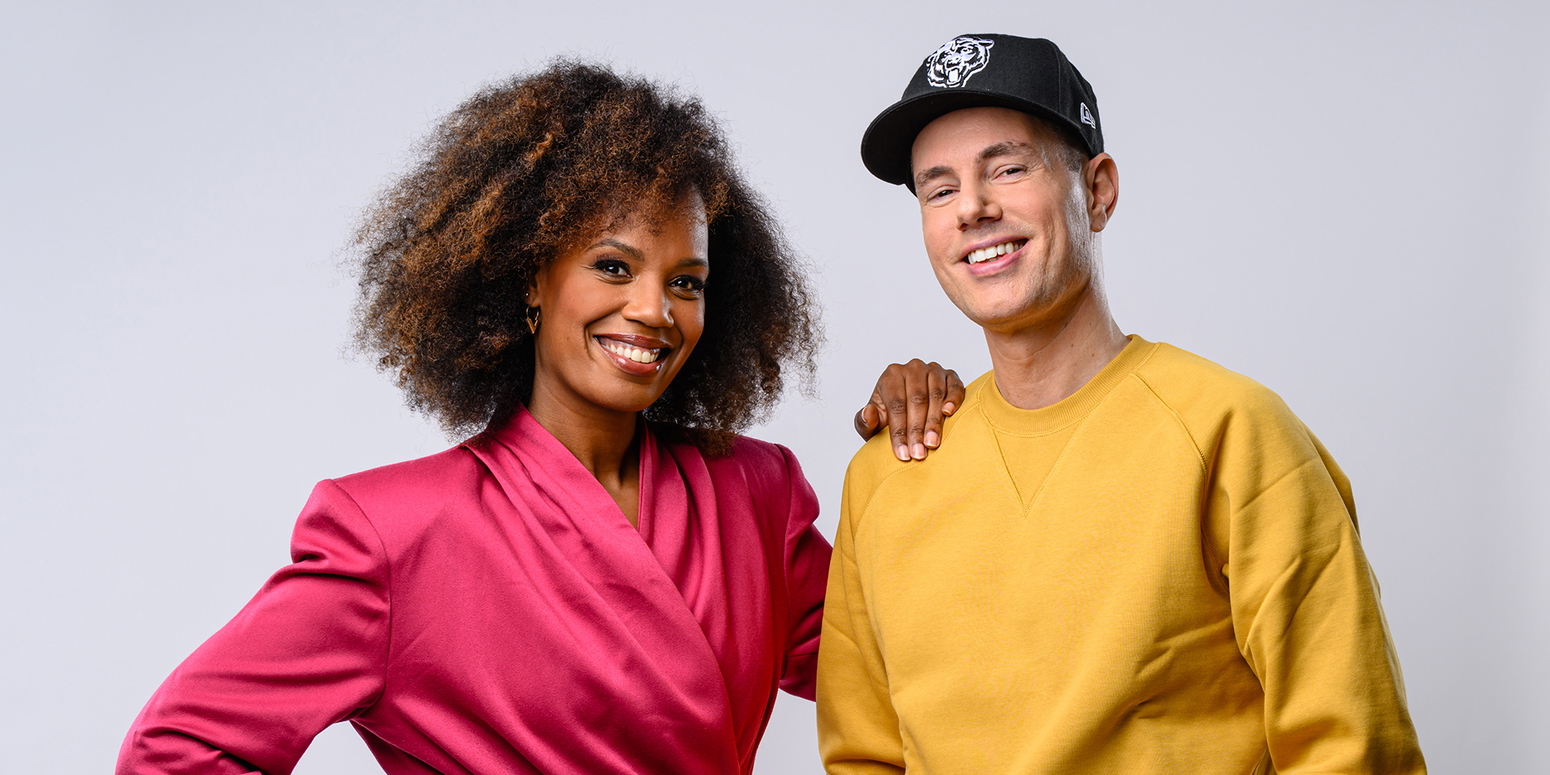21
KIM bespreekt lil Kims nalatenschap en genderpolitiek (NPO BLEND interview)
Klik hier om naar het interview te luisteren (ongeveer na 100 minuten).

Klik hier om naar het interview te luisteren (ongeveer na 100 minuten).

Deze zomer duiken we in een wereld van muziek die meer deed dan alleen vermaken. In onze nieuwe rubriek Historische protestsongs hoor je de verhalen achter de liedjes die wereldwijd aanzette tot denken, actie of verzet. Van chansons tot hiphop, van Vietnam tot Chili; elke week staat een protestsong centraal die de tijdgeest ving en beïnvloedde. We namen de beste tips van jullie – trouwe OVT-luisteraars- mee. Welke artiesten staken hun nek uit? Wat wilden ze zeggen? En waarom raakt hun muziek ons nog steeds? Deze week het nummer Ladies First van Queen Latifah met Kim Dankoor, onderzoeker naar hiphopfeminisme.
Klik hier om het interview te beluisteren.

Luist naar de uitzending via onderstaande Youtube link!
De podcast is overigens ook te beluisteren op Spotify!
Black American commercial rap videos have been criticized for portraying stereotypical gender ideals concerning gender-appropriate behaviors, appearances and attractivity, and heterosexual relationships. We explored to what extent African American college students reject (REJ) and value (VAL) gender ideals in these videos. Additionally, we examined the connections between the perception of these ideals and students’ actual and ought self-images (i.e., attributes they believe they possess and those they perceive others in their social environment expect them to have). We focused on the self-image domains: gender-appropriate behavior, physical appearance, and mate desirability. Social Comparison Theory and Social Discrepancy Theory provided sensitizing concepts for reflexive thematic analyses of focus group discussions on music videos with eight college women and seven college men. Among women the themes were: Black women behave like sexual freaks (REJ); attractive women are exotic-looking (REJ) and naturally thick (VAL); and desirable women mates are beautiful, confident and toned-down (VAL). The themes among men were: Men are playas (REJ) and prioritize making it financially big (VAL); attractive men look fashionable and rich (VAL); and desirable men mates are emotionally distant (REJ) and provide for their partners (VAL). Same-gender comparisons of these ideals with the actual self resulted in both positive and negative self-images and emotions. The comparison of these ideals with the ought self-image resulted in negative emotions. These results demonstrate that portrayed ideals in music videos are relevant to the formation and evaluation of the self during emerging adulthood. Implications for future research and intervention programs are discussed.
Click here to read the article.

Op donderdag 8 mei is de tweede editie van het Hiphopcafé terug in De Basis! Deze editie staat in het teken van jou als (live) artiest, DJ en/of producer. We bespreken hoe je als artiest jouw movement kunt bouwen. Of je nu Hiphop, R&B, Afro of een ander genre maakt, dit is dé plek om te leren hoe jij jouw achterban sterker maakt.



The annual national conference is the Popular Culture Association / American Culture Association’s signature event. Each year, thousands of scholars from many academic disciplines across the globe travel to meet in a major American city to share and discuss their research at the conference in several venues: panel presentations, round tables, special sessions, film screenings, local tours, keynote speaker events, special awards ceremonies, and more. This year’s conference was held at the Marriott Canal Street hotel in New Orleans, from 16 – 19 April 2025. Kim presented the third chapter of her PhD: The importance of the “thick hourglass body ideal” in U.S. commercial women rap for young Dutch Black and White women’s body image. Her session/ talk was part of the Gender and Media Studies research area.
Click here to read her published article.



“Hiphopfeminisme! Nog een prachtige ochtend met hiphop als basis op de Reinwardt Academie. Vandaag doken we met de geweldige Kim Dankoor en evenzo fantastische Rashida Tauwnaar in het fijne House of Hip Hop Utrecht in het concept van hiphopfeminisme en werken met communities. Met muziek van vrouwelijke rapartiesten als basis, verkende en herkende we hiphopfeminisme door de jaren heen.
Onderwijs was een feest deze ochtend, hiphop was een feest deze ochtend met Kim, Rashida en de muziek van Queen Latifah, Roxanne Shanté, Salt ‘n Peppa, Cardi B., Lauryn Hill, Missy Elliot, Big Freedia, Janelle Monáe en Latto.
Wederom ook een shout out naar onze geweldige studenten die al zoveel kennis hebben, geïnteresseerd en open zijn en goede kritische vragen stellen.” (Marlous van Gastel, docent/lecturer Reinwardt academie)


Playlist:
Kim was one of the media professionals/researchers who participated in the Meet & Greet session for students of the course Making Media. This course uncovers what it means and what it takes to make media, focusing on the lived experience of media work. Making Media consists of interactive lectures and weekly ‘meet and greet’ sessions with prominent media professionals.
The invited media professionals are working in all major industries: television, film, journalism, social media entertainment, advertising and public relations, digital games, and music.

U.S. commercial women rappers often promote a “thick hourglass” body ideal in their music. This qualitative study, guided by social comparison theory and self-discrepancy theory, explores how 10 Black and 10 White Dutch women rap fans, aged 18–25, compared their actual body image with this ideal and the emotional consequences that result. A hybrid comparative thematic analysis revealed that both Black and White respondents view the thick ideal as dominant in women rap and part of Black culture. They consider it a standard of beauty and sexiness, when achieved naturally and not through plastic surgery. Comparing their actual body image to this ideal can evoke positive outcomes, such as body satisfaction and the motivation to work toward this ideal through exercise or by choosing clothing that better expresses it. However, it can also lead to negative body images and emotions, such as insecurity, especially when this ideal is perceived as difficult or impossible to attain, or when peers or family expect conformity to this ideal. For Black women, comparison to the thick ideal may result in more positive outcomes, and this ideal is more frequently endorsed by their social context compared with White women. These findings indicate that for rap fans, the Afrocentric thick ideal is more relevant than a Eurocentric thin ideal, highlighting the importance of developing healthy body interventions targeting gender and cultural and contextual beliefs. Further, this knowledge can increase practitioners’ ability to integrate an influential media genre when working with young adults across different cultures. (PsycInfo Database Record (c) 2025 APA, all rights reserved).
Click here to read the article.

Klik hier om het interview te beluisteren.

Klik hier om naar het item te luisteren (ongeveer na 25 min).

In deze nieuwe aflevering van de Nacht van BNNVARA, gaat Jan van Poppel in gesprek met Hiphop-deskundige Kim Dankoor. Kim vertelt over de geschiedenis van het populaire genre Hiphop. Waar komen de teksten vandaan? Waarom wordt er gebruik gemaakt van disstracks? Samen duiken ze in de wereld van Hiphop.
Klik hier om naar de aflevering te luisteren.

I am pleased to announce that I contributed to the third edition of the Amsterdam Museum Journal. This third issue called ‘(Re)production’ is out now! The issue focusses on the role and implications of reproductions in and on our art, cultures and societies. By sharing diverse voices and perspectives, this edition aims to contribute to the understanding of (re)production as it increasingly becomes a part of our daily lives.
Freely accessible via the website of the Amsterdam Museum: (RE)PRODUCTION | Amsterdam Museum.
#Amsterdammuseum #AMJournal
Klik hier om het fragment terug te luisteren.

Elmer, Ray Fuego en Sylvana Simons in het panel ‘Protest’ op No Man’s Land 2024

Rivaliteit is altijd een integraal onderdeel geweest van het genre hiphop. Rapbattles, diss tracks en een beetje opscheppen over je eigen succes ten opzichte van de ander is het genre niet vreemd. Twee van de grootste rappers van dit moment, Kendrick Lamar en Drake, zetten die traditie voort en liggen met elkaar in de clinch. Waar gaat dit conflict over en waarom worden er nu zelfs juridische stappen gezet? Dat zijn enkele vragen van vandaag. te gast: Kim Dankoor. Zij is media-deskundige, hiphop kenner en onderzoekster bij de Universiteit van Utrecht. Ze focust zich vooral op het vraagstuk wat de invloed van commerciële rap is op jeugd.
Luister hier het interview terug.

Haar nieuwe album is het laatste, zegt Mary J Blige. Kortom: tijd voor een ode aan de Queen of hiphop soul. Wat maakt haar dé Queen en wat heeft zij betekent voor vrouwen in de hiphop? Dat vertelt hiphop kenner Kim Dankoor in De Nieuws BV.
Kijk hier het interview terug.

Recent KIM comments